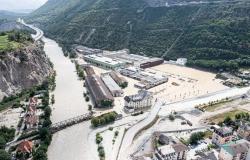Five ways to approach the exhibition differently Dream landscapes by Andō Hiroshige.
Posted at 1:16 a.m.
Updated at 8:00 a.m.
The Montreal Museum of Fine Arts is presenting the prints of Andō Hiroshige until September 8. If the beauty of the works is striking, we can also approach this exhibition in different ways, these representations of life in 19th century Japane century being very meaningful.
Like a history book
If we see 55 graphic works at first glance when entering the rooms of the Museum of Fine Arts, we quickly realize that they are also (and perhaps above all) 55 stories.
These Fifty-three stages of Tōkaidō (because there is the beginning and the end, so 55 prints in total) show the relays that travelers made on the road which separates Tokyo (Edo) and Kyoto. The distance of approximately 500 kilometers was covered on foot.
“It was a means of control for the emperor. The time these politicians and their entourages were on the road, they were not planning a revolution to overthrow power,” says Laura Vigo, the National Gallery’s curator of Asian art.
The curator wrote explanatory notes for almost all the prints. This guides us in the visit, since these notes tell stories. Sometimes very realistic, other times completely fantastical. “Realistic cartography did not exist in Japan,” explains the curator. It was all imaginary. It’s the evocation, the aesthetic. »
The prints are part of the Museum’s collection, which acquired them more than 50 years ago.
Like product placement
“Advertising was invented in Japan, during the Edo period,” says Laura Vigo, who demonstrates that this series by Andō Hiroshige is an eloquent illustration of it. “The product placement blends into the prints,” she says, specifying that visitors will not see, for example, the names of cosmetics in one of the scenes. “Publishers did that,” she continues, “because they had to sell all kinds of products. »
“It’s the beginning of the consumer society as we know it today,” says the curator.
Edo merchants had therefore already understood that these illustrations were a very good way to, more or less subtly, show their brands and their products.
Takenouchi Magohachi, Hiroshige’s publisher, was very sensitive to what the mercantile class wanted. He sometimes requested changes from the designer or printer when a print was not selling well enough. “Hiroshige could in this case change the composition according to what the clientele wanted,” explains Laura Vigo.
Like a travel guide
Although some pilgrims sometimes made the journey, the Tōkaidō route was designed for samurai since the journey was long and laborious. Hiroshige himself came from the samurai class – which gave him some financial freedom.
PHOTO CHRISTINE GUEST, PROVIDED BY THE MUSEUM OF FINE ARTS
Shinagawa, sunrise, wire woodcut. The blue used comes from Germany, imported to Japan. Hiroshige used it to arouse the interest of his customers.
For others who could not even dream of making this journey, the prints allowed them to see the country. “It was a bit like leafing through the National Geographic », Illustrates Laura Vigo.
The prints were printed in 15,000 copies. Hiroshige did one per week for this series.
“During the Edo period, Japan was the country with the highest literacy rate in the world. Everyone was reading. The publishing industry was extremely developed,” says M.me Vigo.
Like crafts
The concept of art did not exist in Japan before it was brought there by Westerners, explains Laura Vigo. Andō Hiroshige was considered an artisan, in the noble sense of the term.
“The idea of art is an extremely Eurocentric concept,” explains the curator. It wasn’t seen that way in Japan or Asia. It is a concept that was applied in Far East Asia only from the colonial interference of the 19the century. »
For the record: some copies of these prints celebrated at the museum today were at the time used as wrapping paper for ceramic bowls…
Like a history lesson
If you visit the exhibition and take the time to read all the explanations that accompany the images, which we recommend you do, you will learn a lot about Japan in the Edo era.

PHOTO CHRISTINE GUEST, PROVIDED BY THE MUSEUM OF FINE ARTS
The prints sometimes show imaginary landscapes. Here, Kanbara, night snow is a good example since… it doesn’t snow in Kanbara.
“I wanted visitors to look at and understand the scene without going into classic formal analysis,” explains Laura Vigo, an archaeologist by training and storyteller. To do this, the curator included anecdotes so that visitors could reach a level of understanding that would otherwise be impossible.
For example, who knew that the white powder used by geishas then contained lead? Sadly, the use of metal killed some of them before they even reached their twenties.
“People will come out knowing more about Japan and the social and political context of the time. »
The exhibition Dream Landscapes by Andō Hiroshige is on display at the Montreal Museum of Fine Arts until September 8
Visit the exhibition page on the Museum of Fine Arts website








